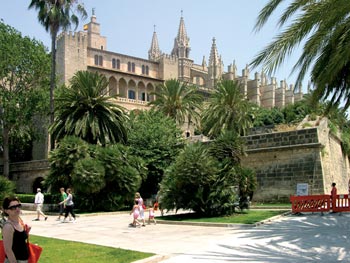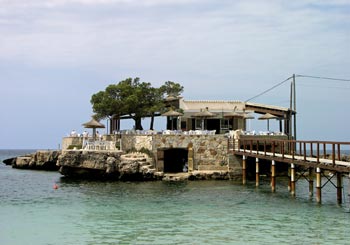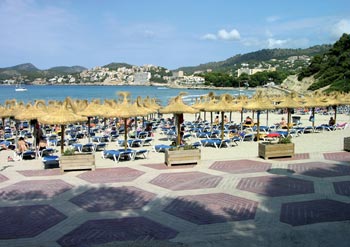Destinations THE TOURIST AGENCY ”POSEYDON TRAVEL” PRESENTS: PALMA DE MALLORCA
The kingdom of beautiful opportunities
The history of this island, the biggest and the most famous among the Balearic Islands, shows us that a house in the middle of the sea shares the destiny of a house in the middle of the road. And everyone in Serbia knows what it means. In the past, on a risky sea border between Christianity and Islam, Mallorca was the Mecca of legionnaires, pirates, warriors… Fleets and armies of Ancient Greeks, Romans, Phoenicians, Arabs and the Catalan people were passing through it... In the second half of the 20th century, while Europe was surviving its war traumas, this was the period of peace and amazing tourist development for Mallorca. Today, this island, with one million residents and 554 kilometers of sea shore, is visited by 15 million tourists a year, which makes it one of the metropoles of world tourism
Text and photographs by: Mišo Vujović
 The Balearic Islands lay in the west of the Mediterranean. South from the most popular Balearic island, Mallorca, and east from Menorko stands the beautiful Cabrera. On the southeast are Ibiza and Formentera, making a part of Pitia islands, with a few smaller islands. In the middle of the last century, Ibiza was called ”the island of pleasure”. It was the hidden millionaires’ oasis and of their lustful descendants from all over the world, the kingdom of night life. Today, Ibiza has many hotels for family holidays which are hidden from the adventurous spirit of the ”island of ecstasy”, as it was called. The biggest island of the Balearic Islands is Palma de Mallorca and it is considered one of the metropoles of world tourism. The Balearic Islands lay in the west of the Mediterranean. South from the most popular Balearic island, Mallorca, and east from Menorko stands the beautiful Cabrera. On the southeast are Ibiza and Formentera, making a part of Pitia islands, with a few smaller islands. In the middle of the last century, Ibiza was called ”the island of pleasure”. It was the hidden millionaires’ oasis and of their lustful descendants from all over the world, the kingdom of night life. Today, Ibiza has many hotels for family holidays which are hidden from the adventurous spirit of the ”island of ecstasy”, as it was called. The biggest island of the Balearic Islands is Palma de Mallorca and it is considered one of the metropoles of world tourism.
One million residents on the island live only from agriculture and tourism. Even if the country is not too generous, almost every inch of it is cultivated. The agronomic complex is working all the time. Everything is adapted to the guest, who can feel all blessings of the earth on these 554 kilometers of the sea shore. Everything is so nicely arranged on these clean sandy beaches: sports terrains, children’s playgrounds, mini-beaches, bars, parking places, showers...
More than 60 per cent of the island is not populated and it is owned by three national parks: Albufera, Dragonera and Mondrago.
Hundreds of hotels lay along the shore, as well as luxurious villas and apartments, hidden beaches, small lagoons in which precious yachts are anchored. In the port Porto Pí, the main piers of Palma, there are hundreds of anchored luxurious yachts whose value exceeds the budgets of many European countries.
As an island in total, Palma has a rich and a diverse tourist offer which everyone can afford ― from small souvenirs, Indian shops, Chinese boutiques and the most popular fashion brands with a luxurious offer and acceptable prices. Beside little shops, moving shops on camionettes and donkeys are a part of that tourist offer. People are selling their goods so relaxed, opposite to the aggressiveness typical for the Mediterranean.
The capital of Mallorca and the Balearic Islands, Palma, a town with 380,000 residents (474,035 including the vicinities), which makes a half the total number of residents of the island. In the vivid architecture of past centuries we can find traces of Rome, Byzantium and the Orient. History claims that the Romans, the Ancient Greeks, the Phoenicians and the Arabs were fighting to conquer these islands.
It is hard to believe that the past centuries have left a desert on this ”heaven on earth”, where important literary, artistic or music works were created. It is obvious that houses in the middle of the sea have the same destiny as the ones in the middle of the road. Maybe the residents of Mallorca are so similar to us, sincere, good-natured, friendly and good-intentioned and because of cruel époques through which they’ve gone through.
FROM THE ROMAN CAMP TO THE CALIPHATE  After conquering Mallorca, in 123 BC, the Romans established two towns: Palmaria, the present Palma, on the south and Pollentia, on the northeast of the island. Palma de Mallorca was established as a military camp on the rests of a community of the Megalithic culture. The Vandals robbed and set fire to Palmaria many times in the ancient times. After conquering Mallorca, in 123 BC, the Romans established two towns: Palmaria, the present Palma, on the south and Pollentia, on the northeast of the island. Palma de Mallorca was established as a military camp on the rests of a community of the Megalithic culture. The Vandals robbed and set fire to Palmaria many times in the ancient times.
There are not many information about the Byzantine period. There are traces left on mosaics found in the oldest parts of the cathedral. From the 8th to the 13th century, Palma de Mallorca was an Islamic caliphate, The Moors started populating the island in the 6th century and after the withdrawal of Byzantium, in 707, the Muslim fleet, commanded by Abd Allah ibn Musa forced the residents of Mallorca to accept to pay tax to the Moors and to become a part of the Caliphate of Damascus. Besides the vassal relations, the Christian population had full economic, social and religious autonomy.
Lying on the border between the Christian and the Islamic world, the island soon becomes the center of pirates and their gangs. Ship robberies from the 8th to the middle of the 9th century become the main economic filed of Mallorca. Because of the more frequent pirate interceptions and ship devastations, the Vikings are invading from the sea in the middle of the 9th century and they rob the island. The army of the Caliph of Córdoba does the same thing, forcing the leader of pirates to stop their sea robberies. The Caliph of Córdoba establishes total control over Mallorca, in 1003, which experienced an economic development and demographic expansion. However, religious and ethnic differences have made interior conflicts which had weakened the central power of Córdoba, after which Mallorca becomes the part of Denia Taifa whose founder was Muyahid ibn Yusuf ibn Ali. In that period, the strongest attacks on Christian ships came from Palma.
In the end of 1087, the Christian punitive expedition attacks Palma, under the command of Ramon Berenguer III, who performed one of the biggest devastations in the tumultuous history of Mallorca, with the Catalonian people, the people of Pisa, of Provence, Corsica, Sardinia. The revenge campaign of Christians, who have not remained on the island, made it possible for the Caliph of Almoravid to establish his power on the island.
In the beginning of the 12th century, the Christian army, under the command of Banu Ganiya Almoravid, with the help of the fleet of merchants and noblemen from Catalonia, goes into a bloody campaign to Mallorca. Morbid acting of the Catalonian army, which finished every clash in cold blood, caused a big infection that killed the conquers as well. Chronicles note that the Muslim population ”escaped” and that the island was populated by the liberators.
Trading with the towns of the Italian and Iberian peninsulas was developing from the 13th to the 14th century. In the beginning of the 16th century, peasants are rebelling against Charles V and Turkish pirates have brought a new period of economic crisis and instability, with intercepting trading ships. The crisis would last until the 17th century when the strengthen inquisition had started to persecute Jews. In the 18th century, intensive trading with the USA is developed and in the beginning of the 19th century Napoleon’s conquer of Spain brought a new crisis and many refugees. In the 20th century, Mallorca is peaceful. In the middle of the past century, while most European countries survived their war traumas, the tourist development on this island had started. In 1960, more than half a million tourists visited Mallorca. Today, that number is much bigger: 15 million tourists a year.
A TOWN FILLED WITH LIFE  In the ancient part of Palma we can see stone houses built in a typical Mediterranean style. Among them are winding streets on which one can hear all world languages. Besides the great Cathedral, the symbol of Palma, there are many animators, street players, acrobats, portrait draftsmen. Everything is a part of the offer. In front of the cathedral the fiacre driver offers a short drive with his two dark-colored horses for 50 Euros, while Charlie Chaplin’s double poses to a group of tourists from Scandinavia. A Bulgarian in a Roman legionnaire’s suit of armor greets holding up three fingers. In the ancient part of Palma we can see stone houses built in a typical Mediterranean style. Among them are winding streets on which one can hear all world languages. Besides the great Cathedral, the symbol of Palma, there are many animators, street players, acrobats, portrait draftsmen. Everything is a part of the offer. In front of the cathedral the fiacre driver offers a short drive with his two dark-colored horses for 50 Euros, while Charlie Chaplin’s double poses to a group of tourists from Scandinavia. A Bulgarian in a Roman legionnaire’s suit of armor greets holding up three fingers.
There are several Hinduistic churches made out of sand on the beach in Pollentia, decorated with candles. One should see the Almudaina palace, from the end of 13th and the beginning of 14th century, built in a Gothic style, the Church of San Miguel from the 14th century, the Church of St. Eulalio from the 13th century, the Church of St. Magdalene from the beginning of the 18th century as well as the Church of St. Antonio built in Baroque style from 1768...
The kingdom of palm trees, after which the capital of Mallorca got its name, is replaced with magnificent buildings. Besides the Almudaina palace, Palma has many beautiful castles, such as Sa Lotia, with luxurious Catalonian and Gothic architecture from the middle of the 15th century, or the Bishop’s Palace, about a hundred years older, or the Roman Arab Fortress, built in 1560, in Renaissance style...
From monumental buildings, the great castle Bellver dominates the town, built in 1309. Besides the Cathedral, it is the symbol of Palma de Mallorca. There are about 10 museums to remember the past centuries, and the most frequented ones are the Military and Historical Museum, the Cultural Center ”Sa Nostra”, the Museum of Modern Art (some of Picasso’s work is kept in it)...
For visiting the ancient part of Palma, one can rent scooters or bicycles, carriages but tourist can also take a taxi, a double-decker bus (with the opened roof) for a sight-seeing tour on the island, while the best way to get to know the island is to take a rent-a-car by very low prices (20 to 40 Euros per day, depending on the time of renting and the car category). Local travel services and agencies are organizing sight-seeing of islands on small boats with and tourist can enjoy the kingdom of the submarine world. One of the attractive tours is visiting the port Solar and the beach La Colabra taking the old wooden railroad.
Nightlife on the island is very diverse, from small bars with live music to clubs and night clubs, among which the most popular one is ”San Amor”, anchored in the 16th century castle.
***
Beaches
On the island, whose protector is The Holy Mother of God Morenta, there are over 80 nicely arranged beaches, the most popular tourist locations, kind of small town-hotels: Magaluf, Palma Nova, Santa Ponsa, Peguera, Playas de Fornel, Costa De La Calma on the south, or Se Colabra, Formentor, Pollentia in the north... The biggest underground cave in Europe is placed on this island, Drach, in which lays the fascinating lake Martel. The oddity of the other cave, Ams (Fishhook), are stalactites and stalagmites in the shape of fishhooks.
*** Pride
Besides its rich cultural heritage, this beautiful green oasis of the Mediterranean can praise with a clear and clean sea, sandy beaches, exotic valleys and lagoons, cheerful and friendly people, good domestic wines, spicy and tasty food, lively music, temperamental players and animators...
*** The builder
In 1232, the Kingdom of Mallorca was founded and after the death of the conquered Jaume I, his son ruled, Jaume II de Mallorca ruled the country. The heir was a great builder and a great founder. He built the beautiful Bellver Fortress, the Church of St. Fransisco, the Church of St. Domingo and he began the building of the monumental Cathedral which dominates the town.
|
